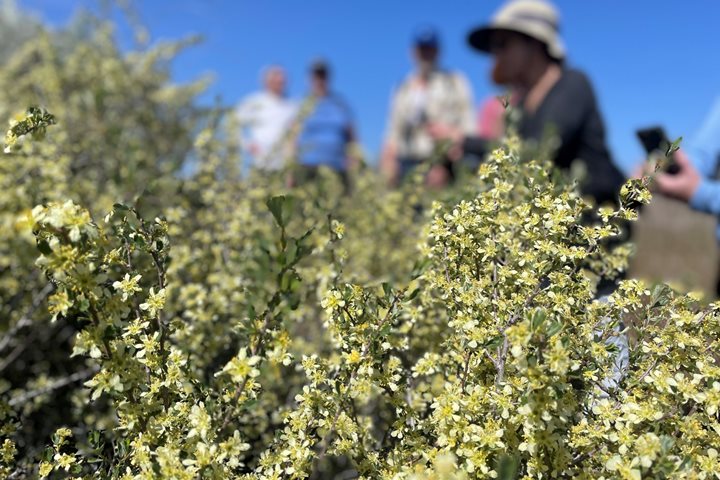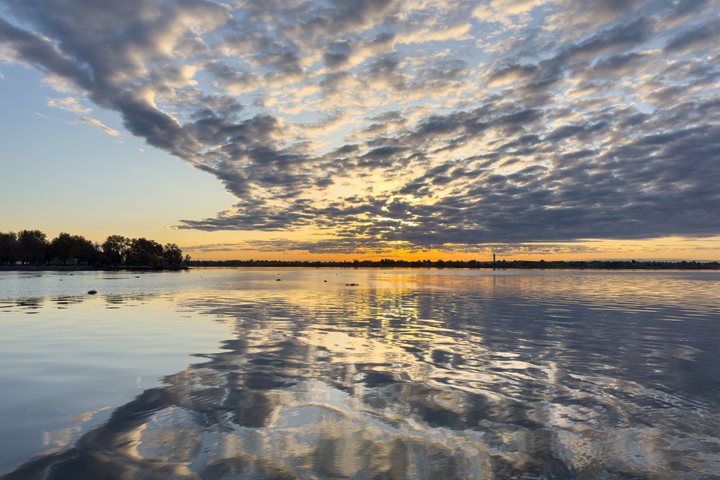At 0600 hours under cloudy skies National Geographic Sea Bird sails upstream on the Snake River. The weather is unseasonably warm, 65 degrees Fahrenheit, and breezy. Early risers are surprised by a darkened lounge with every table holding glowing pumpkins that have been carved into amazing shapes by our artistic crew. Happy Halloween! During the night we sailed from the Columbia, the Great River of the West, onto the Snake River. Soon we are sailing into the lock at Ice Harbor Dam. Once down in the lock we are out of the wind and enjoy the calmness while the American flag and the U.S. Army Corps of Engineers flag whip in the wind on their pole at the top of the lock. Our morning presentation is by Ben Sander and Paul Balle of the National Park Conservation Association and we learn about their work.
We have a following wind so it is very pleasant on the bow and many of us stay out to watch for wildlife and enjoy the beauty of the wind on the water, beautiful clouds, and the brown basalt cliffs trimmed out with the buff colored grasses of autumn. We see flocks of Canada geese, a codgery of coots, a rough-legged hawk, two mule deer does with their fawns, and more. Soon after locking through Lower Monumental Dam we come to some special outcrops of basalt. The first is a great block of dark basalt rock named “Ship Rock” by Lewis and Clark and now called Monumental Rock. Just past Ship Rock on the other side of the river we are astonished by the intricate design made on a hillside by the weathering of the entablature, the blocky-fractured upper layer, of a lava flow. Many suggestions, from an ice-cream sundae to a jellyfish, are made about what this unusual and intriguing outcrop resembles. Our historian, Junius, gives a presentation on the Lewis and Clark expedition.
By noon we are sailing under the Joso High Bridge, a very long and high railroad trestle, and onto the Palouse River. Here we drop anchor, have lunch, and head out for our afternoon activities. The first group to disembark takes our expedition crafts across to a landing where they meet a yellow school bus for the ride to Palouse Falls. Beautiful Palouse Falls drops over a ledge of basalt and plummets nearly 200 feet into its green plunge pool. By now rain has begun to fall and the wind is picking up. The second group sets out in the expedition craft for a tour up the Palouse River. On this adventurous ride we see a beaver lodge, learn about Cattails and Big Sagebrush, and see lots of American Coots on the river. These interesting birds have earned the name of “the splatterer” for their habit of running on the water as they try to get up enough speed to fly. The western grebes wisely dive when we approach—a much more dignified escape from our intrusion. A great blue heron wings its way along the river and lands up on a grassy bench from which it observes our passage.
This land has been parched by drought through summer and early fall so we are happy to see the rain that falls as we are out on the river. The rain brings out the pungent smell of the sage—the smell of the West—and the sharp smell of the willows that line the riverbanks. Even so, it is good to be back on our cozy ship and have a hot drink and enjoy the camaraderie of our social hour.







